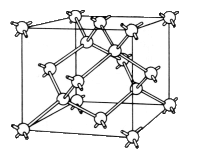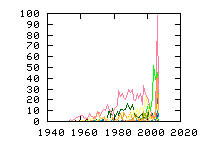« Previous
1
Next »
(6 hits, 1/1)
Showing
10, 25, 50, 100, 500, 1000, all papers per page.
Sort by:
last publication date,
older publication date,
last update date.
- 1. Phys. Rev. B 32, 6571 (1985) , “Electrical Properties of Dislocations and Point Defects in Plastically Deformed Silicon”, P. Omling, E. R. Weber, L. Montelius, H. Alexander, J. Michel.Energy levels of defect states introduced by plastic deformation of n-type silicon have been studied by capacitance transient spectroscopy. From the observed properties of the defects, it is concluded that two different types of defects are produced. The first type is interpreted as point defects... (Read more)
- 2. Physica B 116, 583-593 (1983) , “Investigations of well defined dislocations in silicon”, H. Alexander, C. Kisielowski-Kemmerich, E. R. WeberThe velocity v of dislocation half-loops introduced into swirl-free floating-zone grown undoped silicon has been measured at 420°C in the resolved shear stress range 30 <τ<300 MPa. Clearly impurity atoms interact with dislocations in this material. Using the starting value of v we found the two types of 60° dislocations, which are distinguished by the sequence of their partials, to have different velocities. Furtheron the velocity depends not only on τ, but also on the elastic strain of the lattice. In the second part the papers review EPR spectroscopy of plastically deformed silicon and collects new results on the activity of dislocations in this material as trapping / recombination centers (decay of photo-EPR, photoluminescence, EBIC microscopy and photoplastic effect). (Read more)
- 3. phys. stat. sol. (a) 55, 251 (1979) , “Photo-EPR of Dislocations in Silicon”, R. Erdmann, H. Alexander.The dependence of the EPR spectrum of dislocations in deformed silicon on illumination with monochromatic light reveals the two EPR centers Si - K1 (S < 1/2) to be different ionization states of one and the same dislocation center. The energy level separating these ionization states lies near the... (Read more)
- 4. J. Phys. Chem. Solids 31, 1381 (1970) , “The Annealing of the EPR-Signal Produced in Silicon by Plastic Deformation”, F. D. Wohler and H. AlexanderW. SanderIn silicon an EPR signal is produced by plastic deformation. The annealing behavior of this signal has been investigated, and the dislocation density and structure has been studied by the etch pit technique and by electron microscopy. The EPR-signal anneals in one stage with an activation energy of... (Read more)
- 5. Sov. Phys. JETP 31, 677-679 (1970) , “Electron Paramagnetic Resonance in Plastically Deformed Silicon”, V. A. Grazhulis, Yu. A. Osipyan.Lightly doped silicon crystals were investigated experimentally by the electron paramagnetic resonance method. Paramagnetic centers, generated during plastic deformation of these crystals, were detected. The concentration of these centers increased monotonically with increasing degree of deformation. The EPR spectrum of these centers was anisotropic and had a partially resolved fine structure. The centers werestrongly annealed only at temperature T ≧ 600ºC and the activation energy of the annealing process was ~2 eV. It was concluded that these centers were due to electrons of broken bonds in the cores of dislocations with edge components.
- 6. Solid State Commun. 3, 357 (1965) , “Elektronenspin-Resonanz in Verformtem Silizium”, H. Alexander, R. Labusch and W. SanderBei 800°C verformte Silizium-Kristalle zeigen ein Elektronenspinresonanz-Signal, dessen Intensität mit der Versetzungsdichte zunimmt. Wir vermuten, daβ dieses Signal von ungepaarten Elektronen im Kern von Versetzungen stammt. Durch die Verformung wird die Bildung von Atomgruppen in... (Read more)
« Previous
1
Next »
(6 hits, 1/1)
Showing
10, 25, 50, 100, 500, 1000, all papers per page.
Sort by:
last publication date,
older publication date,
last update date.
All papers (3399)
Updated at 2010-07-20 16:50:39
Updated at 2010-07-20 16:50:39
(view as: tree
,
cloud
)
| 1329 | untagged |
Materials
(111 tags)
Others(101 tags)
Technique
(46 tags)
Details
(591 tags)
Bond(35 tags)
Defect(interstitial)(18 tags)
Defect(vacancy)(15 tags)
Defect-type(19 tags)
Element(65 tags)
Energy(8 tags)
Isotope(56 tags)
Label(303 tags)
Sample(17 tags)
Spin(8 tags)
Symmetry(15 tags)

